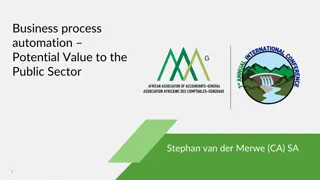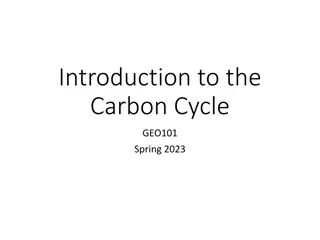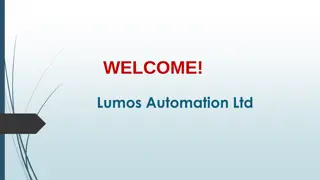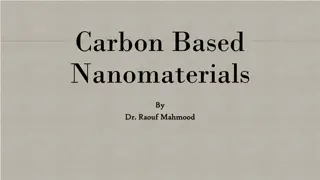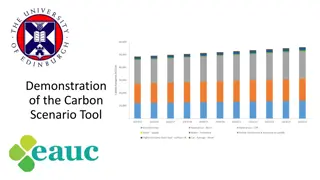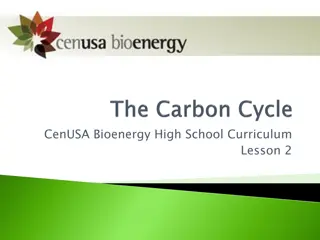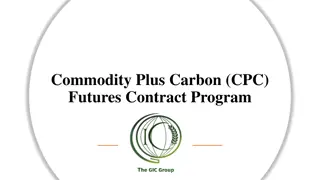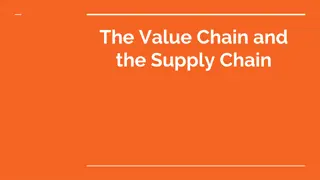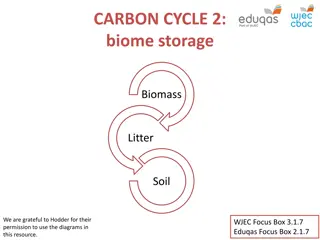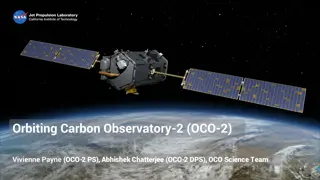Advanced Automation in Carbon Capture Value Chain
How advanced automation ensures integrity across the carbon capture value chain in the Emerson virtual media briefing. Join us on September 13, 2023, at 0830 CDT/1330 GMT.
Download Presentation

Please find below an Image/Link to download the presentation.
The content on the website is provided AS IS for your information and personal use only. It may not be sold, licensed, or shared on other websites without obtaining consent from the author.If you encounter any issues during the download, it is possible that the publisher has removed the file from their server.
You are allowed to download the files provided on this website for personal or commercial use, subject to the condition that they are used lawfully. All files are the property of their respective owners.
The content on the website is provided AS IS for your information and personal use only. It may not be sold, licensed, or shared on other websites without obtaining consent from the author.
E N D
Presentation Transcript
Welcome Thanks for joining the Emerson virtual media briefing. We will begin at 0830 CDT / 1330 GMT
TODAYS BRIEFING How Advanced Automation Ensures Integrity Across the Carbon Capture Value Chain Emerson Virtual Media Briefing September 13, 2023
Media Briefing Logistics RECORDING CHAT Q&A Q&A begins after the presentation. When Q&A starts, I ll unmute you to ask your question. We re recording the session. Every registrant will receive a recording link. Either submit via chat anytime 45-minute presentation Or click on raise your hand during Q&A Q&A to follow
Emerson Virtual Emerson Virtual Media Briefing Series: Sustainability Briefing Series: Sustainability Media How Advanced Automation Ensures Integrity Across the Carbon Capture Value Chain Providing media with insights about how automation helps industries achieve their sustainability and decarbonization goals SETH HARRIS Director of Sustainability, Americas GERARDO MU OZ Sr. Solutions Marketing Manager PAST MEDIA BRIEFINGS Renewable Biofuels Hydrogen Value Chain 4
Emersons Environmental Sustainability Framework GREENING OF How we improve our internal environmental sustainability performance. GREENING BY How we support and enable our customers decarbonization and environmental sustainability efforts. GREENING WITH How we foster collaboration among stakeholders. 5
Emersons Greening By Priorities ENERGY SOURCE DECARBONIZATION ELECTRIFICATION & GRID SYSTEMS CIRCULARITY & WASTE REDUCTION ENERGY & EMISSIONS MANAGEMENT Smart grid & network management New molecules production (Bio-based materials Low-carbon power (solar, wind, hydro, nuclear, biomass) Emissions monitoring & control Energy transport & storage Carbon capture, utilization, storage & removal Materials & minerals recycling & circulation Low carbon fuels (biofuels, biogas, LNG) Workforce safety & productivity Water & waste management Hydrogen & hydrogen- based fuels Advanced controls, analytics & simulation Critical minerals value chains Emerson 2022 ESG Report 6
TODAYS BRIEFING How Advanced Automation Ensures Integrity Across the Carbon Capture Value Chain 8
CCS/CCUS Offers Viable Role in Meeting Net Zero Targets Carbon capture at a point source has a dramatically higher concentration of CO2; However, direct air capture is a way to remove existing emissions Carbon capture represents an estimated 15% of total CO2reductions by 2070 Global energy sector CO2emissions reductions 0 Direct Air Capture Point Source Capture -5 -10 -15 GtCO2per year -20 -25 -30 CCUS -35 -40 2020 2025 2030 2035 2040 2045 2050 2055 2060 2065 2070 Avoided demand Hydrogen Bioenergy Other renewables Electrificaton Other fuel shifts Technology performance CCUS Source: IEA
Advanced CCS: Nexus of Demand, Investment and Adoption CHALLENGES ACCELERATORS Cost per Sector Public Policy Natural Gas DEMAND FOR ECONOMIC PROSPERITY & A JUST TRANSITION Coal to Chemicals Ammonia High CO2 concentration Bioethanol Taxes & Incentives Ethylene Oxyde Hydrogen (SMR) Compression Only DEMAND FOR ENERGY, FERTILIZER, STEEL, CEMENT, CHEMICALS, etc. DEMAND FOR GHG EMISSIONS REDUCTION SERVICES Iron & Steel Low CO2 concentration Cement Technology Power Generation Direct Air Capture 0 200 400 Source: Global CCS Institute
Simultaneous Progress Across Value Chain Necessary to Accelerate CCS Adoption BUSINESS OBJECTIVE Separate and purify complex toxic gas to yield high purity CO2. Efficiently compress or liquify CO2 to the ideal, stable state for transport. Safely carry condensed and liquefied CO2 to storage or utilization sites. Indefinitely and safely secure CO2 at maximum capacity. TOP OPERATING CHALLENGES High Equipment Reliability Transportation Performance Safe Injection & Containment Energy Cost
Capture & Purification: Process Overview Post-combustion Capture Process Overview 1. 2. Flue gas from plant desulfurized. Flue gas rises in absorber. Solvent drops down as CO2 binds to the solvent. Rich solvent is heated in the heat exchanger using steam energy. Stripper separates solvent from CO2. Lean solvent is recycled and sent back to absorber. Pure CO2 is captured. 3. 4. 5. 6. Separate and purify complex toxic gas to yield high purity CO2.
Capture & Purification: An Energy Intensive Set of Processes HOW TO ACHIEVE COST INTEGRITY Streamlining engineering and process design Inefficient process performance due to poor design, asset failure or process variability Reduce pre-treatment consumption Variable CO2 feedstock causes poor capture rate, excess processing Increasing efficiency of heat transfer Business Objective Separate and purify complex toxic gas to yield high purity CO2. Short-lived filtration media due to overuse Increased reboiler efficiency Inefficient, unstable steam production Balancing capture rate vs. energy use Heat exchanger fouling, freezing or plugging causing heat losses High Energy Cost
Streamline Process Design Operational Challenges Value Enablers Impact / Outcomes Costs & efficiency limit project viability and commercialization AspenTech Performance Engineering helps to reduce risks & optimize equipment designs, layout and cost. Increase project viability & support financial decisions with 99% accuracy Scale-up & system integration require higher costs and risk mitigations Ability to Influence Cost Cash Flow Cut design time 50% and execution by 30% Total Cost Established Start-up Establish digital foundation for optimum lifetime performance Performance incongruencies between process models and real-time conditions Identify and predict issues Emerson s digital twin solutions provide dynamic simulations that model physical environments to give valuable foresight into operations. Train operators without impacting the running processes Operators lack first-hand experience and are forced to learn on the job Reduce cost and risk of improving operations
Improve Heat Transfer Improve Heat Transfer Efficiency Efficiency Operational Challenges Value Enablers Impact / Outcomes Reduced throughput from inefficient heat transfer can hinder overall plant capacity and higher energy costs Emerson s portfolio of wireless devices provide a complete picture of heat transfer process performance. Identify process inefficiencies / issues earlier with pervasive sensing Real-time data prevents off-spec product and rework Captured CO2 rework due to off-spec product Operational decisions to identify and correct root-cause of performance deviations can be complex and time consuming to identify Emerson s Plantweb Insight Heat Exchange application provides in-depth monitoring for shell and tube heat exchangers. Reliable, predictive diagnostics based on first principles give foresight to address operational issues Increased/unplanned downtime negatively impact overall carbon capture Reduced energy costs Uptime is optimized to meet environmental goals and maximize revenue Missed emission reduction targets
Balance Capture Rate and Energy Use Operational Challenges Value Enablers Impact / Outcomes Feedstock flow rate can vary dramatically Emerson s DeltaV control system is enhanced by AspenTech adaptive and predictive advanced process or state-based control. 10% reduction in energy consumption Plant operations are intertwined >50% improved overall stability of carbon capture process No APC Stabilize Optimise Operational deviations are not intuitive to manage Sequential processes in the capture process interact in complex ways Incoming gas composition can vary dramatically Emerson s line of gas analyzers and density instruments provide precise results to optimize the entire capture process. Reduced response time from gas analyses enables tighter optimization of capture processes Fluid concentration measurements are not easily obtainable Real-time concentration monitoring provides advance warning in solvent regeneration / recharging Capture operations need to adjust as close to real-time as possible
Compression & Liquefaction: Process Overview Liquefaction Process 1. CO2 moves through a series of compressors, or compressor train, to increase pressure. 2. Intercoolers lower the CO2 temperature prior to the next stage of compression and to condense out the water or other contaminants. 3. Fluid exits compression clean of contaminants, including water, and in the proper state for transport. Efficiently compress or liquify CO2to the ideal, stable state for transport.
Compression & Liquefaction: Preparing CO2for Transportation HOW TO ACHIEVE EQUIPMENT INTEGRITY Monitor rotating equipment Run to failure reactive maintenance strategies Implement preventative & predictive maintenance Poor visibility to wear and tear on critical assets (pumps, compressors, etc.) Lessen impact of corrosion Business Objective Efficiently compress or liquify CO2 to the ideal, stable state for transport. Nature of process contributes to accelerated corrosion Equipment performance can create CO2 phase instability (liquid vs. solid vs. gas) Equipment Reliability
Rotating Equipment and Corrosion Monitoring Operational Challenges Value Enablers Impact / Outcomes Complex, multi-stage process is challenging to control Vibration analytics take the guess work out of predicting failures Emerson s suite of vibration monitoring hardware and software provide real-time monitoring and analysis to prevent failures on critical equipment Fluid instability may exacerbate mechanical stresses Reduce installed cost and enhanced monitoring / analytics for remote assets Heightened awareness for safe operations when operating at high pressures Increased safety thru early detection of potential pipe or vessel failures Emerson s inline and external corrosion monitoring solutions provide early detection of safety or containment risks Pressure containment risks can go unnoticed until failure occurs Reduced risk of captured gas leaking into atmosphere
Transportation: Process Overview Transportation Process 1. Transport stable CO2 in the desired state for accurate custody transfer and fiscal measurement. 2. Continuously monitor pipeline and associated asset health and performance. 3. Efficiently manage wide area operations with real- time monitoring and control to avoid safety events, product contamination, leaks, spills, product loss and false alarms. Safely carry condensed and liquefied CO2to storage or utilization sites.
Transportation: Product & Measurement Integrity HOW TO ACHIEVE PRODUCT INTEGRITY CO2 can solidify due to temperature and pressure fluctuations Maintain ideal CO2 state Enable custody transfer Pipeline inefficiencies restrict flow, reduce capacity Over- or under- pressurization compromises pro duct integrity Business Objective Safely carry condensed and liquefied CO2 to storage or utilization sites. Undetected corrosion leads to ruptures and contaminants Inaccurate custody transfer compromises measurements for financial transaction and transparent regulatory reporting Transportation Performance
Custody Transfer Measurement Operational Challenges Value Enablers Impact / Outcomes Fluid phase changes can cause inaccurate flow measurement Emerson s suite of flow measurement equipment provide flexibility to accurately and repeatably measure CO2 Flow meter diagnostics alert to process disruptions and prevent measurement inaccuracies Flow range requirements can vary dramatically seasonally and asset to asset Accurate measurement across a wide-range of flow rates Measurement accuracy and validation is paramount as the cash register for transactions between two parties Emerson s engineeredflow measurement systems provide turnkey solutions for accurate, verifiable measurement of CO2 Engineered systems ensure confidence in financial transactions Turnkey solution ensures system interoperability from design to startup and long-term operations Multiple skids can cause integration irregularities for CO2 measurement points
Geological Storage: Process Overview Geological Storage Process Overview 1. Study geological candidate sites and begin exploration permitting. 2. Interpret seismic and well data to select storage location. 3. Prove long-term CO2 containment and minimal impact of operations. 4. Obtain regulatory approvals. 5. Develop the storage field and engineer drilling/injection project. 6. Begin safe injection of CO2 and monitor operations. 7. Track CO2 underground displacement over time to ensure permanent geological storage and report to stakeholders. Indefinitely and safely secure CO2at maximum capacity.
Geological Storage: Performance Integrity HOW TO ACHIEVE PERFORMANCE INTEGRITY Compromised physical security of geological formation due to faults, fractures, or improperly sealed wells Assessing geological storage characterization Environmental damage and safety risks due to leakage Custody transfer Induced seismicity, or earthquakes, due to inaccurate volumes of CO2 injection Monitoring and controlling injection Business Objective Indefinitely and safely secure CO2 at maximum capacity. Inability to secure government permits due to incomplete and/or inaccurate characterization of the reservoir Tank gauging and management Increased risks from leakage pathways, pressure build up and induced seismicity due to inability to predict CO2 plume behavior Safe Injection & Containment
Assess and Monitor Geological Characteristics Operational Challenges Value Enablers Impact / Outcomes Site selection is highly dependent on geology Confidently select locations and support permit applications AspenTech s Subsurface Science & Engineering software assesses storage capacity, injectivity and containment for successful carbon storage projects. High risks & uncertainties with CO2 geological storage across lifecycle Engineer projects to de-risk geological storage and maximize CO2 volume Ensure a safe and permanent carbon storage over time. Downhole pressure and temperature are inferred in many cases Operational decisions are based on real-time measurements Roxar Downhole Pressure & Temperature Gauges provide accurate, precise, real- time measurements are crucial to reservoir operations Variance in formation properties can lead poor operational decisions Continuous monitoring provides valuable data for increased well integrity over the life of operations
Monitor and Control Injection Facility Monitor and Control Injection Facility Operational Challenges Value Enablers Impact / Outcomes Extreme operating conditions cause excessive wear and tear on equipment Selecting the correct control valve prevents leaks and reduces the risk for safety incidents Emerson s complete line of severeservice valves ensurereliable operations in the toughest of applications Fluid properties require tighter control to maintain injection rates and integrity from surface to permanent storage Tight flow control for liquefied / supercritical CO2 protects the process even during process excursions Emerson s DeltaV advanced process control solutions ensures safe operations with visibility to mitigate negative impacts to surface or subsurface operations. Poor performance or unplanned downtime will have ripple effects on upstream operations Precise, reliable control of surface equipment reduces failures from complex subsurface operations Complex system dynamics are challenging for an operator to quickly and safely act upon Integration with simulation and engineering software provide confidence for operational decisions
CCS is at the Nexus of Opportunity to Achieve Our Decarbonization Goals BUSINESS OBJECTIVE Separate and purify complex toxic gas to yield high purity CO2. Efficiently compress or liquify CO2 to the ideal, stable state for transport. Safely carry condensed and liquefied CO2 to storage or utilization sites. Indefinitely and safely secure CO2 at maximum capacity. TOP OPERATING CHALLENGES High Equipment Reliability Transportation Performance Safe Injection & Containment Energy Cost
How Advanced Automation Ensures Integrity Across the CCS Value Chain Virtual Media Briefing CHAT Question & Answer Submit your question via chat anytime Click raise your hand during Q&A to be unmuted OR






